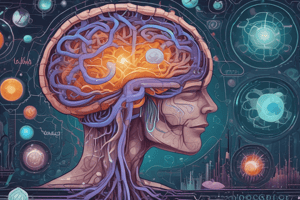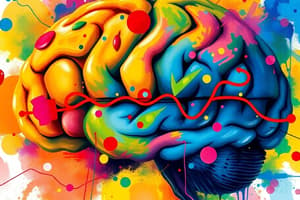Podcast
Questions and Answers
What is the main energy source for our brain?
What is the main energy source for our brain?
Glucose
Most Americans eat enough fiber.
Most Americans eat enough fiber.
False (B)
What is the recommended fiber intake for Americans?
What is the recommended fiber intake for Americans?
25 + 38 grams; 14 grams/1,000 calories
What are the parts of a whole grain?
What are the parts of a whole grain?
What is the glycemic index?
What is the glycemic index?
Define diverticulosis and prevention methods.
Define diverticulosis and prevention methods.
Match monosaccharides and disaccharides with their examples:
Match monosaccharides and disaccharides with their examples:
What is the number one source of added sugar in the average American diet?
What is the number one source of added sugar in the average American diet?
Name some sugar substitutes.
Name some sugar substitutes.
What enzyme breaks down starch into maltose in the small intestine?
What enzyme breaks down starch into maltose in the small intestine?
What hormones are used to balance blood sugar levels?
What hormones are used to balance blood sugar levels?
What are common symptoms of diabetes?
What are common symptoms of diabetes?
What are the outcomes of uncontrolled blood sugars?
What are the outcomes of uncontrolled blood sugars?
How can type 2 diabetes be prevented?
How can type 2 diabetes be prevented?
What do carbohydrates do for physical activity?
What do carbohydrates do for physical activity?
What is the primary fat in our diet?
What is the primary fat in our diet?
Define healthy and unhealthy dietary fats.
Define healthy and unhealthy dietary fats.
What does saturation in fats mean?
What does saturation in fats mean?
Match the types of fats with examples:
Match the types of fats with examples:
What types of fats can lead to heart disease?
What types of fats can lead to heart disease?
Describe the structure of phospholipids.
Describe the structure of phospholipids.
What are the functions of fats in our body? (Select all that apply)
What are the functions of fats in our body? (Select all that apply)
What are the uses of triglycerides in our body? (Select all that apply)
What are the uses of triglycerides in our body? (Select all that apply)
What are good and bad cholesterol levels?
What are good and bad cholesterol levels?
Which fats are made in the body and which need to be consumed in our diet?
Which fats are made in the body and which need to be consumed in our diet?
Match the types of vegetarian diets with their descriptions:
Match the types of vegetarian diets with their descriptions:
What is the energy density for carbs, fats, and proteins?
What is the energy density for carbs, fats, and proteins?
What is gluconeogenesis?
What is gluconeogenesis?
What is the structure of an amino acid?
What is the structure of an amino acid?
What enzyme breaks down proteins in the small intestine?
What enzyme breaks down proteins in the small intestine?
Define transamination.
Define transamination.
What health problems are associated with high and low protein intake? (Select all that apply)
What health problems are associated with high and low protein intake? (Select all that apply)
How is immune health associated with protein?
How is immune health associated with protein?
What are the functions of protein in our body?
What are the functions of protein in our body?
What is the difference between complete and incomplete proteins?
What is the difference between complete and incomplete proteins?
Name a plant-based protein that is complete.
Name a plant-based protein that is complete.
Match complementary plant-based protein sources:
Match complementary plant-based protein sources:
Where does protein digestion and absorption occur?
Where does protein digestion and absorption occur?
Flashcards are hidden until you start studying
Study Notes
Brain Energy Source
- Glucose is the main energy source for the brain.
Fiber Recommendations
- Most Americans do not consume enough fiber.
- Recommended daily intake:
- 25 grams for women
- 38 grams for men
- 14 grams of fiber per 1,000 calories.
Whole Grain Components
- Whole grains consist of three parts:
- Bran: The outer layer rich in fiber and nutrients.
- Endosperm: The middle layer containing starch.
- Germ: The inner layer packed with vitamins, minerals, and healthy fats.
Glycemic Index
- The glycemic index (GI) measures how quickly a food raises blood glucose levels.
Diverticulosis
- Diverticulosis: Small pouches form in the colon.
- Prevention: A high-fiber diet can help prevent diverticulosis.
Carbohydrates
- Monosaccharides: Simple sugars such as glucose and fructose.
- Disaccharides: Sugars composed of two monosaccharides, including:
- Lactose (milk sugar)
- Maltose (malt sugar)
- Sucrose (table sugar)
- The number one source of added sugar in the average American diet is soda.
- Sugar substitutes include:
- Aspartame
- Saccharin
- Sucralose
- Pancreatic amylase is the enzyme that breaks down starch into maltose in the small intestine.
Blood Sugar Regulation
- Hormones that regulate blood sugar:
- Insulin: Lowers blood sugar levels by promoting glucose uptake into cells.
- Glucagon: Raises blood sugar levels by stimulating the release of glucose from the liver.
Diabetes
- Diabetes symptoms:
- Skin dryness
- Sudden vision changes
- Excessive thirst
- Unintentional weight loss
- Slow wound healing
- Shakiness
- Uncontrolled blood sugar can lead to:
- Organ damage
- Cardiovascular disease
- Damage to epithelial cells
- Potential coma
- Type 2 diabetes prevention strategies include:
- Regular exercise
- Balanced diet
- Avoiding alcohol
- Walking after meals
- Maintaining a healthy weight
Physical Activity and Carbohydrates
- Carbohydrates are the primary fuel source for physical activity.
Dietary Fats
- Triglycerides are the primary fat in our diet.
- Triglyceride structure: One glycerol molecule and three fatty acid chains.
- Healthy fats:
- Unsaturated fats (mono unsaturated and polyunsaturated)
- Found in fish, olive oil, nuts, and seeds.
- Unhealthy fats:
- Trans fats: Created through the process of hydrogenation.
- Saturated fats: Found in butter, coconut oil, and red meat.
Fat Saturation
- Saturation refers to the number of hydrogen atoms attached to the fatty acid chain.
- Saturated fats: Fully surrounded by hydrogen atoms.
- Unsaturated fats: Have double bonds between carbon atoms, resulting in fewer hydrogen atoms.
Phospholipids
- Structure: Glycerol backbone, two fatty acids, and a phosphate group.
Functions of Fats
- Transport and absorption of fat-soluble vitamins (A, D, E, K).
- Insulation to help regulate body temperature.
- Components of cell membranes.
- Energy storage for later use.
Triglycerides in the Body
- Stored for energy.
- Provide energy.
- Synthesis of lipid-containing compounds.
Cholesterol
- VLDL: Very low-density lipoprotein (carries triglycerides).
- LDL: Low-density lipoprotein (“bad cholesterol”) – contributes to plaque buildup in arteries.
- HDL: High-density lipoprotein (“good cholesterol”) – helps remove LDL from the bloodstream.
- The body produces cholesterol, but omega-3 and omega-6 fatty acids must be obtained from the diet.
Vegetarian Diets
- Lacto-ovo: Includes dairy products and eggs.
- Pesce: Includes fish, dairy products, and eggs.
- Vegan: Excludes all animal products.
Energy Density
- Carbohydrates: 4 kilocalories (kcal) per gram.
- Protein: 4 kcal per gram.
- Fat: 9 kcal per gram.
Blood Lipid Levels
- Strategies to improve blood lipid levels include:
- Diet: Reduce saturated fat and trans fat intake, increase intake of omega-3 fatty acids.
- Exercise: Regular physical activity can raise HDL ("good") cholesterol levels.
- Medications: Statins can lower LDL ("bad") cholesterol levels.
Gluconeogenesis
- Gluconeogenesis refers to the process of the body converting non-carbohydrate sources (like amino acids) into glucose.
Amino Acids
- Amino acid structure:
- Amine group (-NH2)
- Carboxyl group (-COOH)
- Side chain (R group)
- Central carbon atom
- The side chain (R group) determines the unique properties of each amino acid.
Protein Digestion
- Protease is the enzyme that breaks down proteins in the small intestine.
Transamination
- Transamination is the transfer of an amine group from one amino acid to a keto acid, resulting in the formation of a new amino acid.
Health Problems Associated with Protein Intake
- High protein intake:
- High cholesterol.
- Potential kidney problems.
- Increased urea production.
- Low protein intake:
- Edema (fluid buildup in tissues).
Immune Health and Protein
- Antibodies, which are essential for immune defense, are proteins.
Functions of Protein in the Body
- Building and maintaining tissues.
- Hormone synthesis.
- Maintaining fluid balance.
- Transporting nutrients and oxygen.
Complete vs. Incomplete Proteins
- Complete proteins contain all nine essential amino acids.
- Incomplete proteins lack one or more essential amino acids.
- Soy/tofu is a plant-based complete protein source.
Complementary Plant-Based Protein Sources
- Combining plant-based protein sources that complement each other can create a complete protein profile.
- Examples: peanut butter and bread, beans and rice, barley and lentils.
- Protein digestion and absorption primarily occur in the small intestine.
Studying That Suits You
Use AI to generate personalized quizzes and flashcards to suit your learning preferences.




